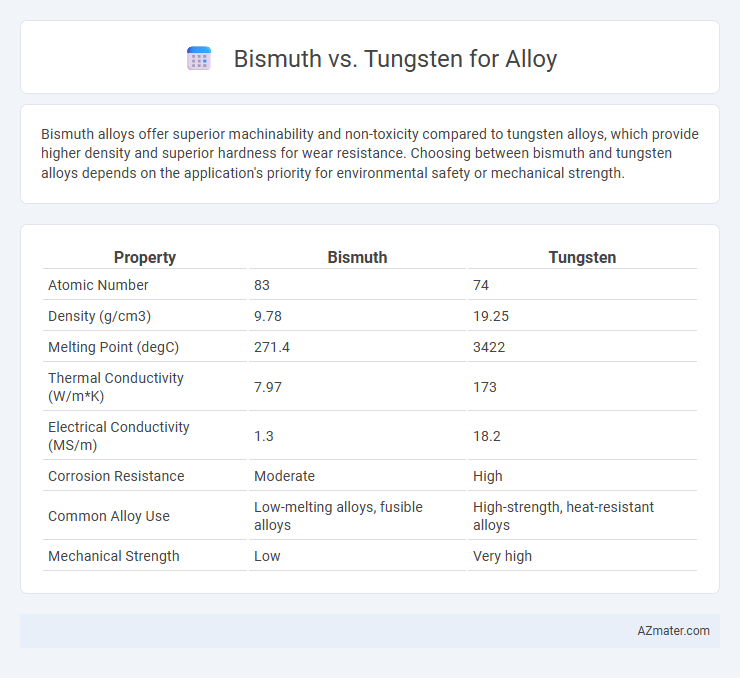Bismuth alloys offer superior machinability and non-toxicity compared to tungsten alloys, which provide higher density and superior hardness for wear resistance. Choosing between bismuth and tungsten alloys depends on the application's priority for environmental safety or mechanical strength.
Table of Comparison
| Property | Bismuth | Tungsten |
|---|---|---|
| Atomic Number | 83 | 74 |
| Density (g/cm3) | 9.78 | 19.25 |
| Melting Point (degC) | 271.4 | 3422 |
| Thermal Conductivity (W/m*K) | 7.97 | 173 |
| Electrical Conductivity (MS/m) | 1.3 | 18.2 |
| Corrosion Resistance | Moderate | High |
| Common Alloy Use | Low-melting alloys, fusible alloys | High-strength, heat-resistant alloys |
| Mechanical Strength | Low | Very high |
Introduction to Bismuth and Tungsten Alloys
Bismuth and tungsten alloys offer unique properties tailored for specific industrial applications, with bismuth known for its low toxicity and excellent machinability. Tungsten alloys provide superior hardness, high melting points, and exceptional density, making them ideal for high-performance uses such as in aerospace and military industries. Understanding these distinct characteristics aids in selecting the appropriate alloy for enhanced durability, weight management, and environmental considerations.
Chemical and Physical Properties Comparison
Bismuth exhibits a low melting point of 271.5degC and high density of 9.78 g/cm3, making it suitable for low-temperature fusible alloys, while tungsten has an exceptionally high melting point of 3422degC and density of 19.25 g/cm3, ideal for high-temperature, high-strength applications. Chemically, bismuth is relatively inert and resists oxidation, whereas tungsten rapidly forms stable oxides at elevated temperatures, impacting corrosion resistance. The difference in ductility is notable: bismuth is brittle and crystalline, contrasting with tungsten's remarkable tensile strength and ductility, influencing their respective alloy uses in thermal management and wear-resistant materials.
Melting Points and Alloy Formation
Bismuth, with a melting point of 271.5degC, significantly lowers the overall melting temperature when alloyed, making it ideal for low-melting-point alloys and fusible applications. Tungsten, boasting an extremely high melting point of 3422degC, contributes exceptional heat resistance and strength in high-performance alloys used in aerospace and military sectors. The contrasting melting points enable tailoring alloys for specific thermal and mechanical properties, where bismuth facilitates ease of casting and tungsten enhances durability and thermal stability.
Density and Weight Considerations
Bismuth has a density of approximately 9.78 g/cm3, making it significantly lighter than tungsten, which has a density of around 19.25 g/cm3, nearly twice as heavy. This difference in density directly impacts the weight of alloys, with tungsten-based alloys being preferred for applications requiring high mass and strength. Bismuth alloys are advantageous where reduced weight and environmental safety are prioritized, especially since bismuth is non-toxic compared to heavy metals like tungsten.
Toxicity and Environmental Impact
Bismuth is significantly less toxic than tungsten, making it a safer choice for alloy applications where human and environmental exposure is a concern. While tungsten is known for its hardness and high melting point, its extraction and processing pose environmental challenges due to potential heavy metal contamination and resource depletion. Bismuth alloys offer a more eco-friendly alternative with lower toxicity and reduced environmental impact during mining and disposal.
Mechanical Strength and Durability
Bismuth alloys offer moderate mechanical strength but excel in brittleness reduction and environmental safety, making them suitable for specialized low-stress components. Tungsten alloys provide superior mechanical strength and exceptional durability due to their high melting point and hardness, ideal for heavy-duty and high-temperature applications. The durability of tungsten alloys far surpasses that of bismuth, which tends to deform under high stress or prolonged use.
Applications in Industry
Bismuth alloys are widely used in low-melting-point applications such as fire detection devices, metal casting, and pharmaceuticals due to their non-toxic, environmentally friendly properties and excellent thermal expansion control. Tungsten alloys are preferred in high-strength, high-temperature environments found in aerospace, automotive, and military industries because of their exceptional density, hardness, and resistance to thermal deformation. The distinct physical and chemical properties of bismuth and tungsten alloys determine their specialized roles in industrial applications requiring corrosion resistance, thermal management, or mechanical durability.
Cost and Availability
Bismuth is generally more expensive and less abundant than tungsten, influencing its cost-effectiveness in alloy production. Tungsten's higher availability and lower market price make it the preferred choice for industrial alloys requiring strength and heat resistance. Cost considerations and resource abundance heavily favor tungsten alloys over bismuth-based alternatives in large-scale manufacturing.
Processing and Machinability
Bismuth alloys offer superior machinability due to their low melting points and excellent chip-breaking properties, making them ideal for precision machining and complex shapes. Tungsten alloys, characterized by high melting points and extreme hardness, require more advanced processing techniques such as powder metallurgy and specialized tooling to achieve acceptable machinability. The contrast in processing methods reflects their respective thermal and mechanical properties, with bismuth alloys enabling easier manufacturing at lower temperatures, while tungsten alloys demand robust equipment and slower machining speeds.
Future Trends in Alloy Development
Bismuth is increasingly favored in alloy development due to its non-toxic, environmentally friendly properties and excellent machinability compared to tungsten, which remains valued for its exceptional hardness and high melting point in high-performance applications. Future trends indicate a growing shift towards bismuth-based alloys in industries prioritizing sustainability, such as automotive and electronics, while tungsten alloys continue to dominate sectors requiring superior wear resistance and thermal stability. Innovations in alloy composites aim to balance bismuth's recyclability with tungsten's durability, driving advancements in hybrid materials tailored for specialized industrial uses.

Infographic: Bismuth vs Tungsten for Alloy
 azmater.com
azmater.com